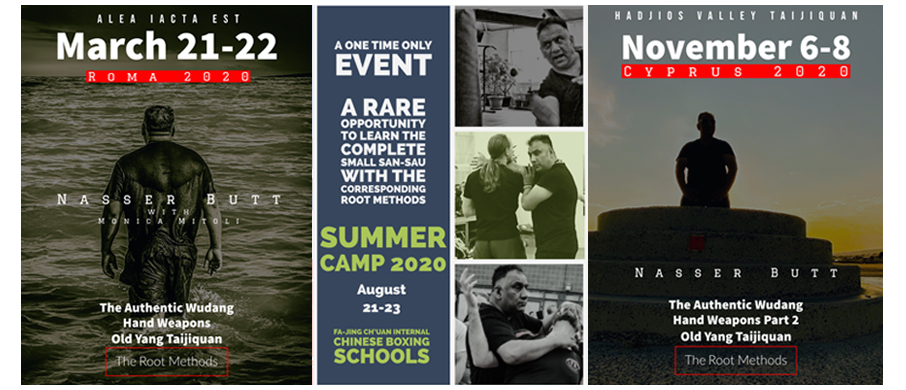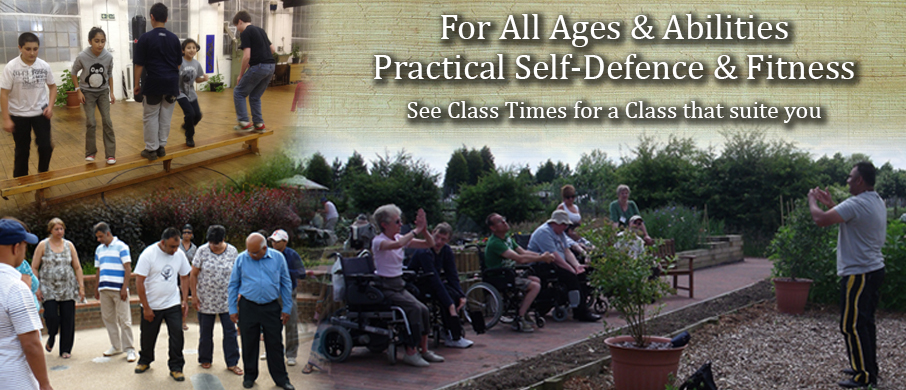The Home Of The Neijia - Taijiquan, Baguazhang
Fa-jing Ch’uan Internal Chinese Boxing School was founded in 2002 by Nasser Butt - Senior Instructor and student of Erle Montaigue (Masters Degree, China). Our aim is simple: To reintroduce the destructive power of Martial Taijiquan ( Tai Chi Chuan ) as its founders intended it to be - for combat, alongside Baguazhang and Xingyiquan and other traditional Chinese Kung Fu Systems. Our methods are simple and realistic, yet, brutally effective!
Powered by fa-jing (explosive energy), the motor of the internal arts and utilising our knowledge of Dim-Mak, inherent within the system, we learn how to repeatedly attack the most vulnerable points of the human body to devastating effect!
From day one we learn about distance, timing, balance, co-ordination and natural body movement, through a myriad of single and two person drills, as well as the classical forms. We learn how to gain and develop fa-jing over a short distance, as well as how to access and utilise our reptilian brain in order to survive.
Through hard training we develop an understanding of the martial principles “hidden” behind the forms as opposed to learning “exotic” techniques, which can and will lose you fights! That's why a majority of martial artists fail against good street fighters! Techniques are for the dojo... behind every technique is an underlying principle, it is this that one needs to absorb, after which the technique becomes redundant! Most martial artists, unfortunately, never get beyond the technique!
If one understands the principles, thoroughly, then they will no longer have the need to remember techniques as the body will move instinctively and deal with the threat appropriately. By preparing the body for combat, we become healthier, physically and mentally, as well as internally and externally. This is how the legendary healing powers of Taijiquan ( Tai Chi chuan ) can be achieved.
Taijiquan (Tai Chi Ch’uan) is a martial art that originated in China hundreds of years ago. The name literally translates into “Supreme Ultimate Fist or Boxing”, and is pronounced in a variety of ways depending on which Chinese transliteration method is used.

Taiji or Tai Chi is sometimes; also, referred to as a soft or internal style – banded in the family of the Neijia, alongside Baguazhang and Xingyiquan. It is considered the “mother” of the internal arts.
It is, obviously, self- evident that martial arts are a system of self-defence and it does not require genius to see the medical benefits of martial exercise! Taijiquan managed to fuse this with the inner alchemy of the human body, as well as, the meditative aspects of Taoism to help achieve self-realisation, both physical and spiritual.
The core of the Taiji system is it’s form, consisting of many postures linked together as continuous flowing, circular movements containing closed fist punches, open hand and finger strikes, kicks, locks and throws.
Thus, the movements of Taijiquan generate, both, centripetal and centrifugal forces encouraging the flow of blood and life-force energy, or Qi, from the centre of the body, out to the extremities and back, along the acupuncture meridians. Thereby, allowing the body to heal and rejuvenate itself over a period of time.
Whilst practicing Taijiquan, one holds no physical or mental tension, or is said to be in a state of Sung (pronounced soong). Sung – a very important concept in Taiji - has been translated, slightly incorrectly, as to relax. However, a more accurate description would be to move without feeling or being aware of the movement itself! For this reason alone, many people find Taiji as an attractive form of stress relief.
However, one should not mistake these soft movements for weakness or passivity! Each posture adheres to a specific martial principle and is linked to one of the acupuncture meridians. The movements are dynamic and resilient, encouraging decisiveness and confidence.
During practice of the martial aspects of Taiji, we learn how to maintain our own balance while under attack, as well as distance, timing and natural body movement, the prerequisites of any fighting art.
It is said in Taijiquan that it is your opponent who decides where, when and how hard he gets hit! In other words, it is your opponent’s body movement and or intent that causes a change within yourself and initiates an appropriate response.
Learning how to deal with change as you go from one posture to another is reflected during form. Whilst spontaneous and instant changes are reflected during the many two person exercises such as San –sau, Push Hands, Da-lu or Pauchui, which teach you the importance of relaxing so that movements are both economical and effective.
Balance, however, can only truly be gained through the understanding and acceptance of change – a lifelong process!
By accepting change as inevitable and responding, or adjusting to it, we can achieve balance on a physical, emotional and intellectual level through the practice of Taijiquan.
Today, millions of people all around the world practice some form of Taiji to gain its great physical and psychological health benefits, while a handful still practice and preserve the original fighting art of old!
However, to truly understand Taijiquan as a whole, we cannot separate the martial from the healing. In other words, only when Taijiquan (Tai Chi) is taught as a complete martial art – as its founders intended – can we really begin to understand the power of it’s healing!
Baguazhang, (also pronounced Pa Kua Chang), is considered to be the daughter of Taijiquan and hence, belongs to the family of the Neijia or internal arts.

The name literally translates to "Eight Trigram Palm," referring to the trigrams of the I Ching - the Taoist Book of Changes, and contains the best of Shaolin and Taoist fighting methods.
The history of Bagua, like Taijiquan, is shrouded in controversy but can be traced back to one man - Tung Hai Chuan (1796-1880), or simply 'Tung the fugitive', a resident of Wen An district in Ho Pei Province.
Tung was deliberately vague about the origins of his martial art and many theories have arisen as to the reason why?
The most commonly held belief is that Tung, himself, invented the form and was too embarrassed to admit it for fear of losing face! It was a commonly held practice in those days to attribute ones work to ancient sages in order to gain respect and acceptance from your peers and society in general.
Another, belief is that Tung was a wanted man, on the run from the law and that was the reason why he was so vague! Whatever, the reasons, one thing is for sure - the art has been added to and subtracted from, over the years, in order to arrive at the highly complex martial and healing form that we have today!
The central core of the system is its form, performed upon the perimeter of a circle generating, both, circular and spiral movements, whilst twisting and turning, and learning to relate our own centre to that of the circle, until all 8 palm changes have been completed. Since we have two hands that would give us a combination of 64 palms (The I-Ching has 8 trigrams and 64 hexagrams) from which one can derive thousands of applications! The 8 palms are known as:
No.1 Palm - Representing Heaven, No.2 Palm - Representing Earth, No.3 Palm - Representing Fire, No.4 Palm - Representing Thunder, No.5 Palm - Representing Wind, No.6 Palm - Representing Water, No.7 Palm - Representing Mountain, No.8 Palm - Representing Clouds.
It is said that Baguazhang has the fastest footwork of any martial art.... this can be attributed to its unique stepping method known as 'mud-stepping'. However, one should note that this a most excellent training method for strengthening the legs, while teaching us effective kicking, balance, timing, coordination etc. - all the prerequisites of any fighting system - and is NOT how we move in a realistic self-defence situation, where the feet usually take care of themselves in 'natural stances'!!
Baguazhang consists of several forms and countless training methods thus, giving us a complete fighting and healing system much like Taijiquan. The forms can be generally broken into:
The Circular Form - This is the most commonly known form.
The Animal Forms - These can be broken down into 3 sections comprising of; The 8 Animal forms, the Animal Qi Shaking Forms and the 2 person Animal Training Sets.
The Linear Form - This a rare and little known form emphasizing the fighting aspects of the art and performed as a 2 person learning aid, much like the Pauchui of Taijiquan.
The fighting art of Baguazhang has been much misunderstood in modern times, leading to some truly exotic fighting techniques being practiced today, alongside purportedly mind-bending esoteric interpretations of certain ideas! This is not our belief...!
Like all good martial arts, Baguazhang develops certain core skills and ideas, giving us the tools which are considered prerequisites of self-defence. However, one must absolutely make a clear distinction between martial arts & self-defence - they are NOT the same thing!
Martial arts are basically designed to teach us certain skills and principles - practicing them does not mean that the practitioner knows how to fight!
Self-defence, however, is where we take these skills and ideas and transfer them into a realistic fighting art for the street through specific training methods.
Baguazhang has 2 main methods of attack and defense:
The larger persons method - for those who are literally able to smash their way through any obstacle offered by their opponent in order to reach their centre and the smaller persons method - reliant more upon the evasive techniques developed through the circular form by moving rapidly to either side and attacking from the rear!
As a healing art Baguazhang is just as effective as Taijiquan.
It, too, acts upon the acupuncture meridians of the human body, sending out Qi along these channels while healing and nourishing the organs concerned.
The constant twisting, turning, and bending during form practice is a great physical exercise for the joints, muscles, tendons and bones as well as the internal organs.
The art of Tung the fugitive was proliferated throughout China by his disciples and their students in turn - Sun Lu-Tang being perhaps the most famed & gifted of the Masters. The genealogy of our school follows as:
This is by no means a detailed account of Baguazhang, but merely an introduction to this amazing art.
Qi (pronounced chee), is our vital life force energy: It can be considered as a bioelectrical force holding us together from conception, the flow of which, if impeded, can lead to sickness or death. It, therefore, stands to reason that in order to remain healthy we need to cultivate this vital life force.

The human body contains twelve main and eight extra acupuncture meridians. These meridians can be looked upon as the body’s network of roads along which the Qi must travel, whilst bathing and nourishing all our internal organs. Traditional Chinese Medicine (TCM) and ancient Daoist texts tell us that the internal flow of Qi is an emulation of the external movements of the human body. In other words, if our external movements are unnatural, then, the internal flow of Qi is also unnatural and hindered.
Taijiquan is a moving Qigong (pronounced chee kung), literally meaning internal work, designed to perform natural flowing movements to enhance the natural flow of the internal Qi. By daily practice, the flow of Qi through all the acupuncture meridians can be increased, improving poor health and increasing strength, whilst inducing a state of calm.
There are literally hundreds of different types of Qigongs, both, static and moving and each one claiming to be better then the rest!
Whilst static Qigong's can be looked upon as harnessing prenatal energy, it is the moving Qigongs that distribute this energy all across the body.
Moving Qigongs, such as the Taiji form, are quite difficult to perform. Trying to relax whilst remembering whole sequences of movements, technical details, proper breathing, yin/yang, opening/closing, balancing of pairs etc. can be an utter nightmare, even for the most competent of beginners. Static Qigongs can clear up most of this clutter and help the beginner gain correct posture and Sung (pronounced soong). They are also a way to get “good things” out of your practice before the form itself, eventually, takes over!
Sung – a very important concept in Taiji - has been translated, slightly incorrectly, as to relax. However, a more accurate description would be to move without feeling or being aware of the movement itself! This meaning becomes more evident as we progress with our training. Suffice to say for now that if we were to totally relax our body whilst doing our Taiji, or any other exercise, we would simply collapse!
Qigongs can be split into essentially 3 categories: those, for self-healing, martial arts and medical use. It is the first two, which primarily concern Taijiquan practitioners, whereas the last is for medical practitioners. The ideal times of practice for Qigong are outside at dusk or dawn. Four breathing techniques are essentially used during practice, depending on one’s experience and level of study and the type of Qigong being performed. These are:
Normal Breath – where the abdomen expands whilst inhaling and contracts whilst exhaling.
Reverse Breath – where the reverse of the normal breath occurs.
Pre-natal Breath – where a rolling of the abdomen occurs.
Tortoise Breath – An advanced form of the pre-natal, where we hold our breath for 7 seconds allowing our inner and outer energies to mix.
Much has been written upon the rules of Qigong and we do not wish to repeat them here. There are several excellent articles & books available on the subject and some can be found in our media section. However, a point we would like to raise is some of the claims made by so-called practitioners of Qigong, which range from the sublime to the ridiculous!
Many tricks are used to dupe people into believing that somehow through the practice of Qigong, they will attain supernatural powers or heal un-curable diseases! Whilst we acknowledge that very little is currently understood about the human brain and its ability to certainly influence our body in what may appear to be a ‘miraculous’ way, most of these claims can be easily explained through the science of physics or in some cases as outright cons!
Many renowned ‘Masters’ claim they can attack and disable an opponent without even laying their hands on them through the use of their Qi! Many tests have been conducted and filmed, where these ‘Masters’ have failed to achieve their claims on any person other then their own students! The social network site YouTube, is full of such videos, which have debunked these theories yet, still, these Masters are paraded and allowed to earn substantial sums from their absurd claims!
Circus tricks, such as, the bending of spears on the throat, the breaking of stones using bare hands, lifting heavy weights attached to the genitals etc. are all offered as proof of Qi and Qigong. Some self-styled ‘esoteric warriors’ claim even claims of inanimate objects, such as, daggers moving of their own accord, and levitation!
All this has lead to another ‘new’ breed of Taijiquan practitioners and schools who reject the concept of Qi outright, thus leaning towards the no less an extreme opposite side of the spectrum! This is not surprising, yet is as equally foolish a position as the former! There are some practitioners who have been practicing the ‘Internal’ for merely a decade or less, yet feel that they are in a position to pit their experience against thousands of years of Chinese study and experimentations on the subject, and, with a mere wave of their hands dismiss this deep history!
What both these positions show is perhaps a lack of understanding of the subject in some cases and serious falsifications in the rest!
Daoist breathing techniques and related exercises have been used for many a millennia by both, martial artists and non-martial artists alike. Using the breath to cultivate energy and strengthen the body can be found amongst the indigenous peoples of almost every land on this globe we call earth!
What we need to do is to strip away the crazy notions and see and practice Qigongs for what they are… essentially a beautiful way to unify mind, body and spirit. Leading us to calmer, healthier lives and an inner strength, which can be called upon in the time of battle!





